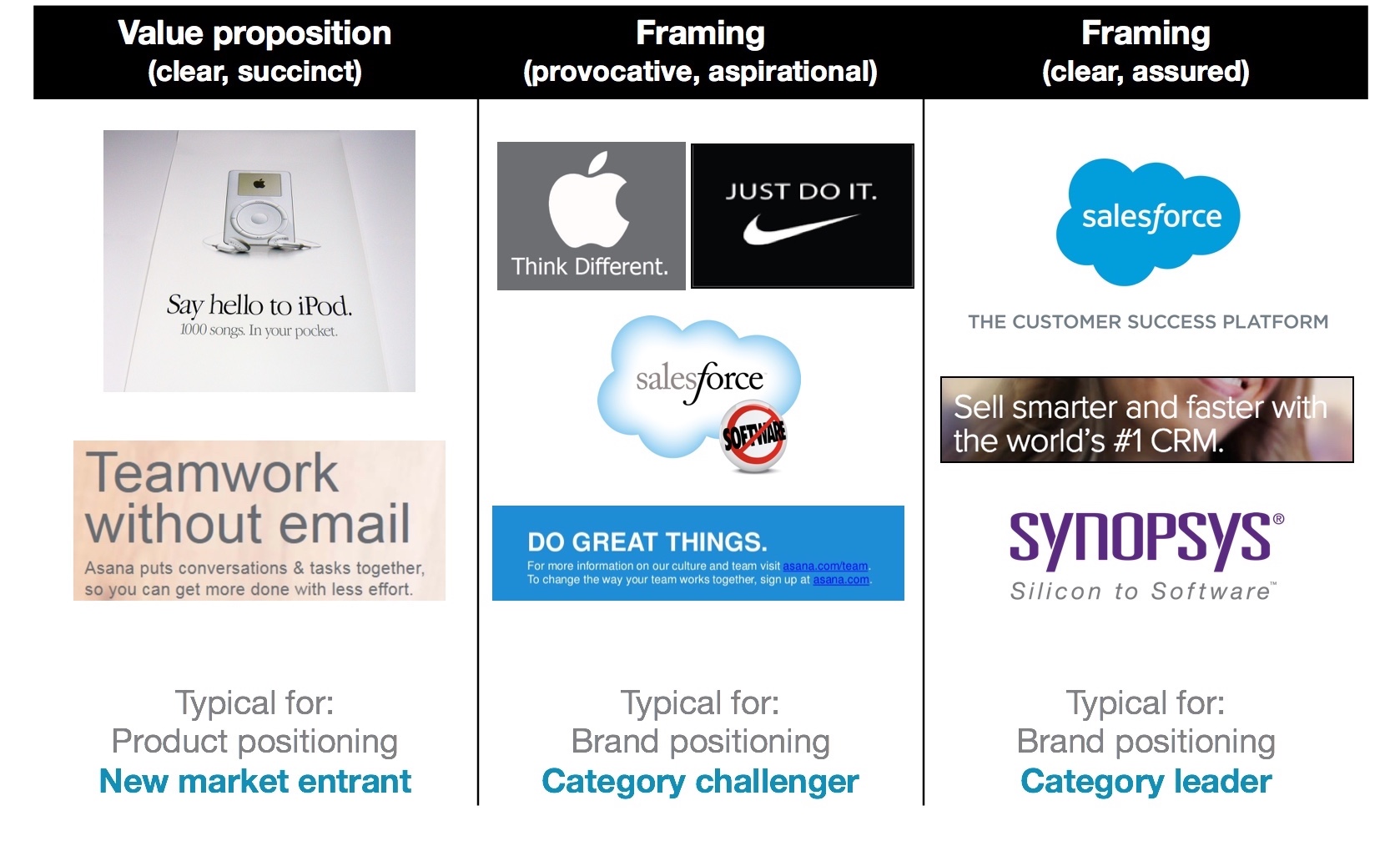Positioning is important for every organization. Yet there is no consensus on what the term means.
Among positioning experts, Michael Porter talks about strategic advantage, Seth Godin talks about purple cows, and Clotaire Rapaille talks about tapping into enduring cultural archetypes. Are we really all discussing the same thing?
Here is a simple description that I use to align teams and viewpoints:
Positioning defines how external audiences see a company or product relative to its competitors.
In practice, positioning answers three questions:
- Where are we in the competitive landscape?
- What is the nature of our offering?
- How are we situated in stakeholders’ hearts and minds?
Let’s look at each of these questions one by one.
1. Where are we in the competitive landscape?
This is a pure business strategy question.
Answering it involves:
- Quantifying the Total Addressable Market (TAM) and each pertinent category and customer segment
- Assessing the company’s absolute and relative presence within those categories and segments
- Acknowledging disruptive trends that could change the boundaries or dynamics of the relevant categories
- Assessing the strengths and potential trajectories of known competitors in the market
- Defining a strategy for maintaining and expanding our beachhead
- Ensuring we’ve segmented the market in a way that’s rational and aligned with investor and analyst perspectives and our own business goals
There are many potential formats for drawing competitive maps, including spider and bubble diagrams, 2×2 grids, and more nuanced, data-rich analyses. The primary audience for these maps is internal, since organizations typically don’t want to share their game plan with the outside world, except in closed-door meetings with trusted partners such as analysts, key clients, board members, and large investors. Once finalized, these maps of where-we-are and where-we’re-going directly inform the strategic plan, product roadmap, and any M&A strategy.
Competitive maps can either expose or obscure important business risks. These risks tend to occur in predictable patterns. Here are some specific risks that I look for:
- We don’t know what category we’re in.
- We understand product categories but not customer categories.
- Our category is dominated by larger players with whom we can’t compete.
- Our category is shrinking.
- There is no real category—we’re a feature or fad.
- We don’t have a clear distribution strategy to maintain our position.
- We are optimizing for distribution partners who will eventually squeeze us out.
- Our market segmentation doesn’t acknowledge critical risks, disruptive trends, or indirect competitors.
- We lack internal alignment to maximize our preferred position.
- We lack full understanding of regional barriers to entry and critical success factors.
One facilitation tool I use to surface and resolve gotchas like these is the Eat Big Fish framework that I shared in an earlier post. This is an admittedly crude tool, but it quickly forces companies to articulate the specific categories they are leading. Baked into the tool is the idea that every company must eventually become the leader of its core category.
At the end of this exercise, an organization will have:
- a bespoke, comprehensive view of the competitive landscape
- a defensible point of view regarding its placement and relative size within that space
- the existing or emergent category (or niche) it wants to lead
- the investment strategy to protect the current position and expand to its desired future position
- the measurable share of market it wants to own over a specified time period
This is the best possible foundation for a solid and scalable marketing plan.
But a visual depiction of our place in the market doesn’t by itself answer how an organization should communicate to the outside world. For that we need to turn to the next question…
2. What is the nature of our offering?
This is a pure a marketing strategy question.
The answer typically comes in the form of a “positioning statement.” There is a template for creating these that’s widely known and often taught, and it reads something like a Mad Lib:
For [insert Target Market], the [insert Brand] is the [insert Point of Differentiation] among all [insert Frame of Reference] because [insert Reason to Believe].
I’m going to break ranks with some fellow marketers and say that I hate this template. I have two problems with it. First, many companies try to use it as a starting point to excite and engage customers, and at that it fails miserably. Second, I have never seen a company actually use this template to write their external copy.
Notice that organizations often do use something along these lines in their PR boilerplate, as Nike does here:
NIKE, Inc., based near Beaverton, Oregon, is the world’s leading designer, marketer and distributor of authentic athletic footwear, apparel, equipment and accessories for a wide variety of sports and fitness activities.
But that lick of copy is about a zillionth as exciting and memorable as a typical Nike ad:

Also note that the Nike positioning statement omits both the Reason to Believe and the Target Market. That’s fairly standard, in part because most companies have multiple Target Markets and Reasons to Believe.
My own, more open-ended formula for creating an external positioning statement is as follows:
Describe the company/product in a way that’s clear, relevant, different, and better for a broad range of likely audiences.
That’s it. Good positioning statements that meet these criteria, like the Nike one above, help companies describe themselves in an intentional, ownable way. At the end of this exercise, a company will have a thoughtful, effective way to describe itself to a general or unknown external audience. They are invaluable in aligning internal teams, investors, partners, and press.
But that one sentence doesn’t give us everything we need to capture the hearts and minds of our target customers. For that, we must turn to our third question…
3. How are we situated in stakeholders’ hearts and minds?
This is a pure brand strategy question.
In order to position ourselves effectively in our customers’ minds, we can’t just chant the words we want them to remember… we must design our experiences carefully across our entire marketing mix, and ensure that all the interactions our employees have with the outside world reinforce a singular and positive impression.
A good tagline helps, but words simply reinforce or influence the overall customer impression—they don’t create it on their own. Notice that most taglines make no sense out of context: imagine “Think Different” on a Lenovo computer or “Just Do It” on a can of spaghetti sauce. Brand strategy is about creating the right context, not just finding the right words.
Brand building requires a deliberate, consistent integration of design, stories, rituals, behaviors, experiences, and products so that our words acquire emotional resonance and intellectual credibility with our specific target audiences.
Brand positioning tends to require a different approach as companies grow and evolve.
New market entrant
If you are a niche player or new market entrant, just lead with your primary user value proposition—the specific emotional or functional benefit you provide. If you’re small or new, you want people to understand your unique value quickly, without too much poetry or a time-consuming set-up. (Some well-funded, category-creating companies skip this stage.)
Category challenger
As you move into a “challenger brand” position, taking on your local market leader, you must amplify your distinctive difference. Here’s when it makes sense to lead with a Big Idea, one that’s a bit provocative, maybe even a slow-get.
Category leader
Once you’re the market leader, you will want to trumpet the fact that you’re king of the mountain, perhaps while beginning to assert an even broader aspiration—i.e., becoming a challenger once again.

That’s my short and sweet introduction to positioning. If you’re interested in further reading, I recommend Venkatesh Rao’s 2010 blogpost, the works of Michael Porter, Clayton Christensen, Steve Blank, and strategy+business magazine (for market positioning) and Al Ries, Jack Trout, Seth Godin, George Lakoff, and Clotaire Rapaille (for brand positioning).
You can also sign up for The Next Us newsletter, where I regularly share ideas related to business and personal transformation.
In the meantime, I’d love to hear from you. Which of the three positioning questions above is your organization struggling with? What specific challenges are you facing?


Leave a Reply